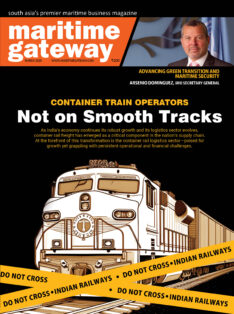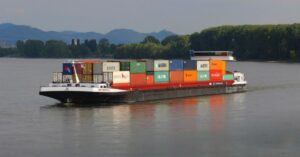Ocean Sparkle Limited (OSL) is India’s leading port operations and marine services company. With a presence across all major ports in the country, the company is recognized as a ground breaker in the industry with world-class marine services, most advanced vessels, highest quality, and unmatched experience. P. Jairaj Kumar, Chairman & Managing Director of the company details on his journey in providing O&M, dredging services and expansion plans.
You have an extensive seafaring career and also a land-based career with different positions in diverse industries. So, how did you get into this port operation and management sector which you started in 1995 and how was the journey in the last couple of decades that you have been running this company?
Having sailed for 9 years and having been to the ports across the world, I always felt that there was a need for good port management systems in India. The privatization of the ports which came in during the mid-90s actually provided us the opportunity. When minor ports came into being, the concession agreements by the minor ports provided flexibility for the developer to outsource the operation and management of the port. What we do as a part of the O&M is a comprehensive marine service which includes pilotage, provision of tugs and support craft, control tower operations, mooring services, fire and safety patrols, pollution control, maintenance of navigation aids and all of this to give a single point of accountability to the port developer. So, we first started this activity in Kakinada where the government of Andhra Pradesh built the deep water port at Kakinada and outsourced the marine services at this port. As you know, India is a very large provider of marine manpower to the merchant marine, but what OSL took upon itself is to train these marine manpower in the skills of port management. So, we first started with Kakinada Port where we provided services of pilotage, towage and all the other services to give a single point of accountability to the port developer. So, in essence, the answer to your question is that the privatization of the ports gave us this opportunity to get into this segment.
Let us talk about the recent past, Covid-19 pandemic has affected every business including our industry. So, what was the impact on O&M operations because port business also is affected to some extent and now with vaccine coming in, people are talking about economy taking a V-shaped recovery and budget also I think lifted the hopes of people. So, how was the last one year for you and what do you look forward?
So far as the Covid times were concerned, as you are aware, port services were declared essential services. So, right from March when the lockdown was announced, we continued to provide services at the ports. It is true that the traffic at the ports in the initial months took a beating, but from June onwards, there was recovery and today we are almost close to about 70% to 80% of the traffic. Fortunately for us, our O&M business is based on long-term contracts of a take or pay nature. We provide a service and we get paid a daily wage for the services that we provide for. So, in terms of revenues, we were not affected very drastically although they were some ports, some minor ports, especially captive ports which had to shut down their factories because of Covid and hence the ports which are attached to those factories had declared force majeure on us, but this was for a very short period; again the industries resumed and ports started to operate so we continued to provide our services.
Of course, this was at huge logistic nightmare for us because we operate in 30 different ports across the country and to keep people safe from being infected, you can well imagine that a tug boat has got 10 people; if any one gets infected, you can be rest assured that all the 10 would have been infected. So, it was a huge challenge for us and everybody rose up to the occasion. In fact, for the first 7 months of COVID, I had 1800 people spread across the country and I didn’t have a single case of COVID. But after 7 months, people were impatient and I do understand that they have been onboard for over a year. People at home got affected with COVID and so we had to resort to some sign-ons and sign-offs and we were of course affected in some way but we were able to contain it very effectively and we never even, for a single day were not providing service to the 30 ports that we operated.
You mentioned about the budget. I am very happy that in my 30 years of experience ashore, this is the first time I have heard shipping being mentioned in the budget, although it may not directly impact our vertical but the subsidy announced to Indian flagged vessels to compete in tenders which are coming out by PSUs would be a distinct advantage to the Indian shipping companies and I am sure a larger amount of cargo would be carried by Indian vessels coming into India. The other thing we are looking forward to, we are waiting the details are the 7 PPP projects that have been announced in the major ports and we are awaiting those details and we hope that there would be something for us also in this PPP mode of privatization.
I understand that you are also into dredging business. Is it capital or maintenance or both? How is that segment doing?
Dredging was a late introduction into our portfolio. We came into dredging only in 2005, almost 10 years after we started this O&M service and the reason for that was that many of the minor ports where we provided a comprehensive service had to do some amount of maintenance dredging year-on-year and they found it extremely difficult to charter dredges from all over the world to come and do a maintenance dredging of say 1million cubics where the mobilization, de-mobilization of the dredgers was more expensive than doing the dredging itself. For Ocean Sparkle this was a different financial model because on the O&M services we work on contract basis but here, our revenues depended upon the volume of dredging that we do, but considering that we were in several of the minor ports and the managements of the minor ports had requested us to take on this activity, we went in to acquire few dredgers and started this activity in the minor ports in 2005, exclusively for maintenance dredging. We then moved on to inland waterways, lakes and canals and have done some very prestigious jobs like the Lalbagh Lake in Bangalore, the Ramgarh Lake in UP and we are now executing very large desiltation project in the Mahanadi River in Orissa.
Today, we specialize in lake rejuvenation and environmental dredging, which means that we don’t only dredge, we also desilt and separate the solids and put back clear water into the lakes. We have done such good work where the input water was a million PPN of solids; when we put back, the solid content is less than 10 PPN and there are water parks which have come in these places. We see this as a very potential segment because this is a thrust area of several state governments to clear up their water bodies and develop water parks. So, today, dredging contributes almost 15% of our annual revenue and we hope to do much more work in this segment as well but we are not into captive dredging, we are only into maintenance dredging, dredging of inland waterways, lakes and canals.
Since you just mentioned inland waterways, that brings me to ask you on two important areas of our industry – one is coastal shipping and another is inland waterways. We have been talking about these two segments for long and government also wants to encourage this mode of transportation. Industry also made lot of efforts. You are also one of the passionate advocates of coastal shipping. So, what is your take now, the current scenario or the way things are moving on coastal shipping and inland waterways?
So, coastal shipping, we always believed that India, with such a vast coastline will definitely yield for a coastal transportation network. But the drawback at that point of time, at least we were one of the first guys to bring in a tug and barge combination into India way back in 2002 and we did some coastal voyages between Paradeep and Haldia. We did voyages between Thailand and Haldia. But it was during the infancy of coastal shipping. Today, several minor ports have developed which can be effectively tied up with a coastal transportation system and the second most important thing is that the government has realized that there has to be a separate code for construction of these vessels, separate manning standards, whereas in the years when we entered that segment, a coastal vessel had to be equivalent to an ocean-going vessel and which was a very expensive proposition.
So, today we have a near coastal vessel cadre of people and the thrust given by the government for construction of RSV vessels which operate on the coast. Third, the push which has been given to the major ports to provide exclusive berths for these coastal vessels and not to go through the same rigmarole of customs, immigration, port health which delays the cargo moving around. I think the time is right; today, the only thing which still holds back coastal shipping is the cargo support. We often realized that although transportation by sea would be very competitive, but the absence of cargo on the return leg is one of the difficult things that we have to contend with and I believe that every mode of transportation had some support from the government. We are not asking for any subsidy; just like when railways came into being when the government said fertilizers, all fertilizers will be transported by rail rakes. Something of that sort to give assured cargo support would definitely bring in a lot of new players into this segment and I think we are definitely on the anvil for a very large coastal fleet to come in due course of time.
So far we have talked about lot of good things but tell me, what are the challenges or threats you see in your line of business? Now, ports may stop expansion after sometime because maybe we can expect another 3 to 4 ports to come in India. Second, we are looking at a consolidation where you have hardly one or two operators across both the coasts. So, what are the threats you see for your business?
Well, in terms of growth, I think we have been able to achieve at least 10% to 15% CAGR year-on-year. I do appreciate that this may not be possible as we grow larger but our thrust segments in business today are one, of course, minor ports and energy terminals, the LNG terminals which are coming out new, and of course the minor ports which have already been developed and which are growing as well. For example, in Krishnapatnam, we started with two tugboats. Today, we have 4 tugboats operating in Krishnapatnam. Same with Kakinada and so on. The other major segment for us is the major ports. Major ports initially started to privatize tugboats which are only incremental requirements of tugboats but having seen the efficiency of the operations of the private tugs, today, even the replacement demand of the major ports is being catered to by private players like us.
In effect, if you see, in JNPT, probably in the year 2000, JNPT had 10 tugs of its own. Today, JNPT does not have any tugs of its own. All the 10 tugs which operate in JNPT are privatized tugs and all the major ports are going in this same direction. With regard to consolidation, yes I think in the private ports, there has been consolidation but by the quality of services that we have provided, even the new acquirers have also continued our services in the ports and today, we are not looking at India alone although India provides us the bread and butter for growth, we are also looking actively at the international segment. We have operated before in Sri Lanka, Saudi Arabia, Nigeria, in Aramco in Saudi Arabia. So, we are looking at other countries like Bangladesh, Myanmar, Iraq which are also providing contracts of long-term nature and we believe that internationally, we would be a strong player as well at least in the near Asian region.
If you want to put across to Ministry of Shipping or Ministry of Commerce, Logistics Department, what are the three key issues that you would like the government to address. What is your wish list?
I think first and foremost is till date, we used to acquire ships from world over at most competitive prices and passed on the benefit to the ports in the charter rate that we operate. Today, government has given a directive to the major ports that henceforth, all the tugs in the major ports would be India built. In fact, we are very happy to construct; I mean, there is absolutely no problem if the quality, timelines and the price are realistic. From what our experience has been in the past, the Indian shipyard prices are at least 20% to 25% higher than the international market. Now, today, if I construct a vessel at this price, this price has to be passed on in the form of a charter rate to the ports. Already there is a big hue and cry that the logistics costs in India are high and one of the biggest culprits in this is the vessel-related charges at the ports where if you compare an Indian port to a neighbouring port such as Colombo, the vessel-related charges are already 5 to 6 times over and above what is charged at a neighbouring port.
So, we really had to see whether the ports will be able to absorb this additional cost. I believe unless and until there is competition, I mean, it should not become a monopolistic practice out here where somebody is forced. I am an international operator and I build vessels for operating internationally, right. Second is, today the contracts what major ports are giving between 5- to 7-year period. Nobody amortizes a tug in 5 to 7 years. We require at least 15 years to amortize, not only to payback and give a reasonable charter hire to the port. So, length of the contracts to be increased is the second thing. Third is funding. Even today, we don’t get funding on such long-term basis at international prices to compete. These are all global tenders and in order to be competitive, we have to be competitive in every aspect of the business. So, if there is a special fund which is in fact, we are happy to build in India so as long as the other parameters and we are competitive in meeting the expectations of the port. So, these are probably the 2 to 3 things which come my mind immediately and these are things which are very current at this moment of time and one more thing is that, services like us, as we are providing services to international vessels which are calling, our services which are provided from India to an international client and they used to be eligible for export incentives such as the SFIS scrips. Our fervent appeal to the Commerce Ministry is that this is a service that has a foreign exchange journey and this SFIS Scrips in the form of an export incentive should be continued to the segment.











